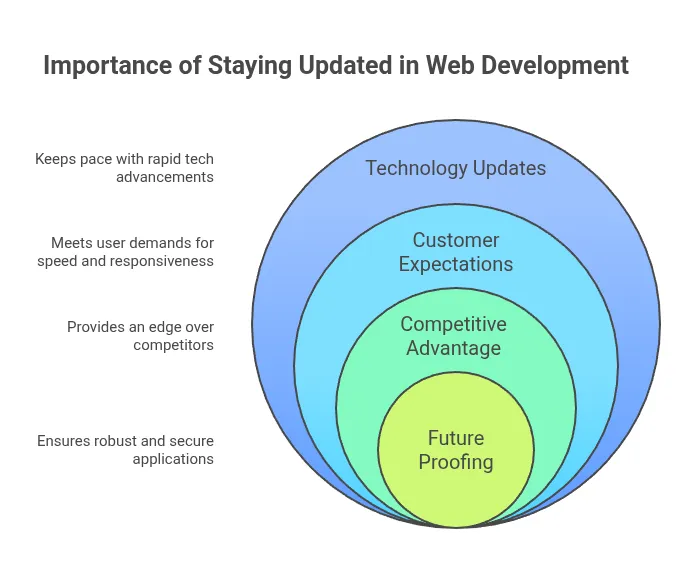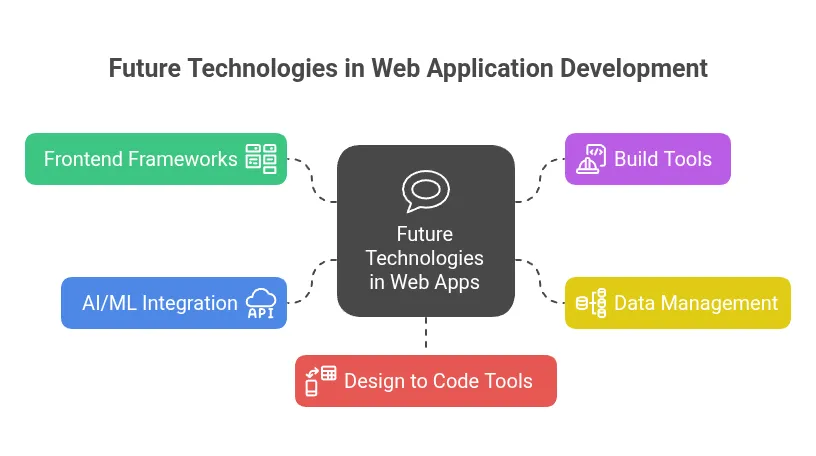Table of Contents
Web application development is growing and evolving faster than ever.
With users expecting smarter, faster, and more seamless digital experiences, the pressure is now on businesses to adapt and deliver better.
Falling behind isn’t an option, and it is going to hurt the performance and engagement, and competitors might take advantage.
With the entrance of amazing new AI and tools, it is really important to stay updated about trends.
So, let’s understand the trends.
Why Staying Updated with Web Development Trends Matters?
There is a reason we should be updated with trends and especially when it comes to web application development.

If you’re providing web application development services, then it is important to know all these:
1. Technology Becomes Outdated Fast
Web tech is growing rapidly. Different tools and frameworks, and practices are cutting-edge in two years; they might slow down now.
If you’re still stuck with tech stacks that are slow and have performance issues, then it’s time to make changes.
2. Customer Expectations Are Shifting
With a laggy system, you won’t stay relevant for long because it will push users away. To avoid that, you can add blazing-fast load times, seamless interaction,s and mobile responsiveness
You can’t forget AI-driven suggestions and chat support.
3. Competitive Advantage
If you’re an early adopter of new technologies, you can have many advantages, and with that, you can have an edge over your competitors.
Whether it’s leveraging serverless infrastructure for speed or AI for personalization, modern web practices can reduce development cycles, lower costs, and deliver standout experiences that attract and retain users.
4. Future Proofing For Scalability And ROI
Investing in web trends and tech is really vital for you to scale effectively and adapt quickly to change.
It’s not just about following trends; it’s more about building web applications that are robust, secure, and staying relevant for the upcoming times.
10 Web Application Development Trends to Watch in 2025
Here are the top trends we should know about. And web app development companies need to know about these a lot.
1. AI-Powered Web Applications
AI is changing the way web applications are used to interact. From now on, you will see how more web apps are going to be used.
- LLMs (Large Language Models) for chatbots, content generation, and search enhancements.
- Recommendation systems that personalize content, products, or user flows.
- AI automated workflows are influencing productivity inside apps.
Having these features makes your apps more intuitive, efficient, and user-focused. While also reducing manual features.
2. WebAssembly Adoption
WebAssembly allows every developer like you to run performance code in your browser that was traditionally written in C++, Rust or Go. This means:
- Using this will allow you to execute faster than JavaScript for compute-heavy tasks like video editing, 3D rendering.
- Porting existing desktop applications to the web easily. Now the majority of the developers are moving into WebAssembly.
3. Progressive Web Apps (PWAs) Taking The Mainstream
With the PWAs, you can combine the best of web and mobile apps:
- They load instantly even if they are offline.
- It can be installed on devices without going through an app store.
- They support push notifications and background sync
In 2025, many industries and businesses, such as e-commerce, fintech, and media companies, are going to embrace PWAs to cut mobile development costs and to offer fast app-like experiences through the browser.
4. Serverless Architecture
With serverless, developers can write good code without worrying about managing servers or infrastructure.
Cloud providers handle all of that
- Frameworks like AWS Lambda, Azure Functions, and Vercel simplify scaling and performance.
- It becomes cost-effective as you only pay for what you use.
In 2025, the model will be widely adopted for everything from APIs to backend workflows and event-driven functions.
5. Edge Computing For Real-time Web
With edge computing, you can bring data closer to where users are, rather than relying on central servers. With this, you can have:
- Much lower latency period
- Real-time processing for apps like video conferencing, gaming, financial dashboards, and personalisation engines.
Edge runtimes will power this transformation so well, especially in global-facing applications
6. Multi-experience Development Platforms (MXDP)
MXDPs help build apps once and deploy them all across multiple channels: web, mobile, smartwatch, voice assistant, AR/VR, etc.
- Platforms like Mendix, Appian, and Oracle MXDP simplify cross-platform experiences.
- Businesses can maintain a single logic layer but customize UX across devices.
As more businesses interact across different platforms and devices, a strategy that can provide multi-channel experiences will give much more value and become important for engagement.
7. Low-Code/No-Code Development
Now the low-code and no-code market is on the boom. Platforms like Outsystems or Mendix (low-code platforms) and Webflow or Bubble (No-code platforms) enable faster application development with minimal to no code.
It sounds amazing and saves a lot of time.
- Non-tech team can contribute to app creation.
- Developers can speed up internal tools or MVP launches.
In 2025, expect more enterprises to integrate these platforms for productivity while keeping control over security and scalability.
8. Privacy-First Development
Privacy policies are getting stricter day by day all across the world. (GDPR in Europe, DPDP in India, HIPAA in healthcare).
As a result:
- Developers must build with privacy by design principles.
- Expect increased use of encryption, zero trust models, and consent popups.
In 2025, if you want to build a web app, then following through the Privacy policies is way more important than ever before.
9. Chatbot Will Reduce Operational Cost
Chatbots are taking the market by storm, and it is very crucial to use them.
By 2027, the conversational market is predicted to grow to almost $30B, and it shows how big it is going to be.
With chatbots, you can do a lot of things:
- It will enhance your customer experience and support 24/7, and reduce operational costs.
- Overall, improving the website’s user experience.
If you’re still in doubt about whether to use a chatbot or not, then you might need to rethink again.
10. Enhanced API First Development
APIs are the backbone of modern web applications, and with them, you will be able to integrate everything quite easily.
- Headless CMS platforms separate content from presentation.
- GraphQL APIs enable more efficient data fetching.
- BFF (Backend to Frontend) architectures tailor APIs for specific frontends
This flexibility allows businesses to reuse logic across platforms and innovate faster.
Working with a web app development agency will help you in structuring your plan and executing it properly.
Technologies Powering The Future Of Web Apps

There are a lot of technologies that are powering the future of web application development in 2025. It includes frameworks, tools, and platforms as well.
If you’re planning to create web application development software, then knowing tech is vital.
Let’s understand each one of them:
1. React 19 And Solid JS
React remains the most dominant frontend framework, and its upcoming version is meant to improve performance to the next level.
Meanwhile, SolidJS is quickly gaining popularity for its ultra-fast rendering capability and fine-grained reactivity.
This is making it an excellent choice for performance-critical or web application development software.
2. Vite And Turbopack
When it comes to development, speed matters a lot. Tools like Vite and Turbopack are taking over from their older versions like Webpack.
Vite offers instant startup, hot module replacement, and lightning-fast builds especially for frameworks like Vue, React, and Svelte.
Turbopack, developed by the creators of Next.js, is pushing performance even further.
3. GraphQL
As Apps become more dynamic and data-driven, traditional REST APIs are starting to fall short.
GraphQL steps in with a flexible, query-based approach that lets frontends request exactly the data they need.
It’s more efficient, faster, and especially powerful for apps that pull data from multiple sources.
4. AI/ML Libraries
AI is now part of a serious web strategy. Libraries like TensorFlow.js allow developers to run machine learning models in the browser directly.
Hugging Face makes it easy to integrate pre-trained models for tasks like text generation, classification, and translation.
5. Figma To Code Tools
Design handoffs have always been a bottleneck – until now.
Tools like Locofy, Anima, and Figma’s developer plugin now allow developers to integrate UI into clean, reusable code for frameworks like React, Vue.
How do These Trends Impact Businesses And Developers?
Businesses looking for web application development services need to be updated about this, as well as developers need to be updated about these trends completely.
Here’s how it will impact both.
For Businesses:
- Reduced Time-to-market with serverless and low-code tools.
- Improved scalability and cost efficiency via cloud-native approaches.
- Better user engagement through AI-driven personalization
- Stronger data compliance and future readiness in regulated industries.
For Developers:
- Higher demand for full-stack capabilities, including AI, APIs, and frontend frameworks.
- Increased reliance on automation and developer experience tooling.
- Getting a shift towards modular, composable architectures that are easier to scale and maintain.
- Need for cross-functional collaboration
Experienced web app development companies are going to benefit from this extremely.
Conclusion
If you’re someone who is not catching up with the trends, it’s time to rethink again because in 2025.
You need to make web application development software high-speed, intelligent, and more personalized.
Businesses that embrace these trends and prepare their team accordingly will always be in a better position.
And if you’re someone who is providing web application development services, this is a must.
FAQ
Q1. Which framework is best for web development in 2025?
There’s no any one fit size for all. But React 19 remains the popular and widely adopted frontend framework in 2025.
Especially, being a web application development company, you must use this.
Q2. What are the types of web application development?
There are several types of web application development, and they can be categorized into several types:
1. Static Web Apps
2. Dynamic Web Apps
3. Progressive Web Apps
4. e-Commerce Web Apps
5. Portal Web Apps
Q3. What Is The Concept Of Web Application Development?
Web application development is the process of designing, building, and deploying software applications that run in web browsers.
It involves both frontend (client-side) and backend (server-side) development to create interactive platforms that users can access via the internet—on desktops, tablets, or mobile devices.
Q4. What Is The Best Web Application Development Company?
The best web development company depends on your goals, needs, and budget as well as industry. Here is a list of the company:
1. HyScaler – Known for high-quality and AI-driven web application development solutions.
2. Toptal – Great for hiring elite freelance developers or teams.
3. Thoughtbot – Excellent for custom web and product design
Q5. Is Web App Development In Demand?
Absolutely, yes. Web application development remains one of the most in-demand skills in 2025. Businesses across all sectors—from startups to Fortune 500s—are investing heavily in modernizing their web platforms to meet digital-first customer expectations.